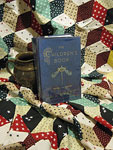Historic Stories, Fictional Accounts: Achieving Multiperspectivity
Question

What is the significance of examining historical events from multiple perspectives (i.e. use of fiction, nonfiction, etc.) on an elementary school level?
Answer
Examining historical events from multiple perspectives introduces elementary students to core aspects of history and historical thinking. And as with much of history, it has relevance to helping students become more prepared for the responsibilities of citizenship, college, and career.
Imagine that students are learning about early American settlements. Depending on where you teach and your curriculum, this might include learning about the Mayflower and Plymouth, Jamestown, or the Missions in California. Students read stories or textbook accounts of these early settlements and they learn the difficulties of the passage here and making a new life in a foreign land.
Yet, this is only part of the story and to get a fuller picture, students need to consider the perspectives of those not necessarily represented in these accounts—most obviously, the perspective of the indigenous peoples who were here when the settlers arrived. (Viewing the settlements from this alternative perspective is not necessarily easy given that the historical record is incomplete, but using artifacts, surviving legends, historic sites, or even settlers’ first hand accounts can help students imagine this perspective.) Considering this missing perspective helps students recognize and articulate that people can experience the same event in different ways.
Students can learn to ask, whose voices are we not hearing? What perspective is not represented? What alternative stories are told about these events? Did participants in these events agree on their meaning? What might account for these differences in perspective?
This is a key piece of doing history—understanding that there are multiple perspectives and multiple stories that surround historical phenomena. And elementary students can learn this. Connections to daily life can be made, as students are familiar with such things as sifting through playmates’ differing accounts of recess events. Multiple perspectives can also be introduced in very concrete ways to young students. They could view something from different locations to see different aspects of it, or use tools such as a cardboard picture frame to see how a frame is selective--including some aspects of the view while ignoring others.
Ideally, students can learn to ask the same questions of daily life and sources that they learn to ask of history: Whose voices are we not hearing? What are the other stories that people tell about this issue? How and why do they differ?
You ask particularly about the use of fiction and nonfiction to teach multiple perspectives. See this entry about “book sets” a strategy for including both to engage students and guide them toward deep understanding of historical events. Also see this roundtable where panelists discuss the use of fiction in the elementary classroom or this blog.
Using both fiction and nonfiction allows students to engage with multiple kinds of text and it allows you, as teacher, to use the texts for different purposes. Good fiction can be used to engage and interest students in the past and help them imagine that past or create a picture of the historical context of the events you are studying. Non-fictional texts, such as primary sources, can be used to explore an experience or perspective in more depth and to represent missing perspectives. Both can be used to challenge students to look across and synthesize texts to create a fuller picture of the past.
A critical aspect of using both fiction and non-fiction texts together is that they give you an opportunity to teach students the difference between the two. Young students can learn that history is an evidentiary discipline and strives for the most accurate and complete picture of the past, whereas fiction does not have this constraint. While there are examples of fictional stories that try to do the same, this basic distinction is an important one for students to learn.
Teaching young students that history includes multiple stories and perspectives aligns with the Common Core State Standards, and can prepare students for future history classes and academic work. But, more significantly, it is critical for helping students understand that their perspective can be partial and does not represent all peoples—it can help them develop empathy and be more skeptical of the single account as the one true answer in our complex world.
